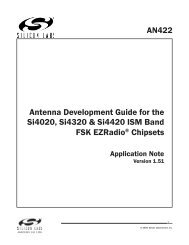C8051F326/7 - Silicon Labs
C8051F326/7 - Silicon Labs
C8051F326/7 - Silicon Labs
Create successful ePaper yourself
Turn your PDF publications into a flip-book with our unique Google optimized e-Paper software.
5. Voltage Regulator (REG0)<br />
<strong>C8051F326</strong>/7<br />
<strong>C8051F326</strong>/7 devices include a voltage regulator (REG0). When enabled, the REG0 output appears on<br />
the VDD pin and can be used to power external devices. REG0 can be enabled/disabled by software using<br />
bit REGEN in register REG0CN. See Table 5.1 for REG0 electrical characteristics.<br />
The voltage regulator is enabled on reset. When the device is self-powered from a 3V supply net, the regulator<br />
may be disabled in order to save power. Important Note: If the voltage at the regulator input<br />
(REGIN) is greater than the Core Supply Voltage (VDD), the voltage regulator should not be disabled.<br />
Otherwise, permanent damage to the device may occur.<br />
Note that the VBUS signal must be connected to the VBUS pin when using the device in a USB network.<br />
The VBUS signal should only be connected to the REGIN pin when operating the device as a bus-powered<br />
function. REG0 configuration options are shown in Figure 5.1 - Figure 5.4.<br />
5.1. Regulator Mode Selection<br />
REG0 offers a low power mode intended for use when the device is in suspend mode. In this low power<br />
mode, the REG0 output remains as specified; however the REG0 dynamic performance (response time) is<br />
degraded. See Table 5.1 for normal and low power mode supply current specifications. The REG0 mode<br />
selection is controlled via the REGMOD bit in register REG0CN.<br />
5.2. VBUS Detection<br />
When the USB Function Controller is used (see section Section “12. Universal Serial Bus Controller<br />
(USB0)” on page 87), the VBUS signal should be connected to the VBUS pin. The VBSTAT bit (register<br />
REG0CN) indicates the current logic level of the VBUS signal. If enabled, a VBUS interrupt will be generated<br />
when the VBUS signal matches the polarity selected by the VBPOL bit in register REG0CN. The<br />
VBUS interrupt is level-sensitive, and has no associated interrupt pending flag. The VBUS interrupt will be<br />
active as long as the VBUS signal matches the polarity selected by VBPOL. See Table 5.1 for VBUS input<br />
parameters.<br />
Important Note: When USB is selected as a reset source, a system reset will be generated when the<br />
VBUS signal matches the polarity selected by the VBPOL bit. See Section “7. Reset Sources” on page 57<br />
for details on selecting USB as a reset source.<br />
Table 5.1. Voltage Regulator Electrical Specifications<br />
V DD = 3.0 V; –40 to +85 °C unless otherwise specified.<br />
Parameter Conditions Min Typ Max Units<br />
Input Voltage Range 2.7 — 5.25 V<br />
Output Voltage Output Current = 1 to 100 mA 3.0 3.3 3.6 V<br />
VBUS Detection Input Threshold 1.0 1.8 2.9 V<br />
Bias Current<br />
Normal Mode (REGMOD = ‘0’)<br />
Low Power Mode (REGMOD = ‘1’)<br />
—<br />
—<br />
75<br />
41<br />
111<br />
61<br />
µA<br />
Dropout Voltage (VDO )* IDD = 1 to 100 mA — 1 — mV/mA<br />
*Note: The minimum input voltage is 2.70 V or V DD + V DO (max load), whichever is greater.<br />
Rev. 1.1 31


